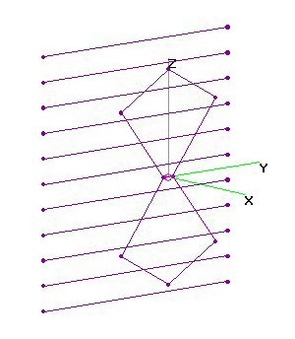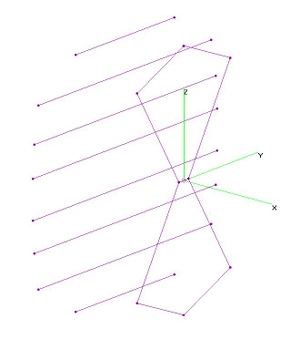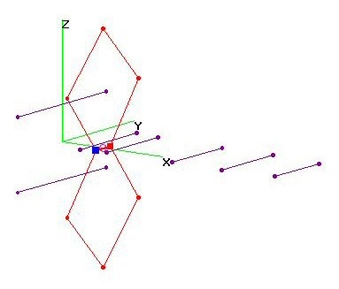 | 1.
Compare Bi-Quad Performance (23 Jun 2013)Compare Bi-Quad Performance to other Antennas.
Mclapp M4 (10x9.5) 4-Bay provides the best Raw Gain, with CM4228HD close behind, except for
additional Gain Loss on lower channels (which might NOT be that much, see CM4228HD results).
Stacked 8-El FD-Yagis (with 2 Reflectors each) provides better Raw Gain and esp. F/B & F/R Ratio
than the 15-El "Double-Quad" Yagi (Stacked 8-El Yagis, except one common Bi-Quad replaces
two Active Elements).
7-El Quagi and 7-El Bi-Quad Yagi provide lower Raw Gain (as expected) but with minimal
F/B & F/R Ratio performance on mid-band and higher freqs.
EDIT (27Jun2013): Updated Comparison Chart with improved results for Stacked 8-El FD-Yagis (w 2-Reflector Rods).
EDIT (4Jul2013): Added two Comparison Charts, including 8-El FD-Yagi (2RR) and 8-El Bi-Quad Yagi (2RR). |
| 5085 Visits
3 Images
Shared Album | |
|
 | 2.
UHF Bi-Quad + 11RR - OPT (6 Mar 2015)UHF Bi-Quad with 11 Reflector Rods analyzed using 4nec2 after determining dimensions using
nikiml's Python Optimization Scripts.
UHF Raw Gain = 9.8 to 11.1 dBi, F/B & F/R Ratio Min. = 18.4 dB and SWR (300-ohms) Under 2.5.
Hi-VHF Raw Gain = 5.0 to 5.7 dBi, F/B & F/R Ratio = 2 to 14 dB and SWR (300-ohms) = 773 to 133 is Excessive
SUMMARY OF DIMENSIONS:
Feedline Separation = 2*feed = 1.0-in,
Y-Coord of Outer Apex=y1 = 5.125-in,
Z-Coord of Outer Apex = z1 = 6.0-in,
Z-Distance from Outer Apex to Top = z2 = 3.0-in,
ALL Elements AWG10 & RR QICT,
RR Separation behind Hourglass = 4.25-in,
Reflector Rod-to-Rod Separation = 2.125-in,
RR Half-Lengths = 10.0-in. |
| 8499 Visits
21 Images
Gallery Album | |
|
 | 3.
UHF Bi-Quad NO Refl - khaye (13 Mar 2011)UHF Bi-Quad with NO Reflector (per khaye post) analyzed using 4nec2.
Element Diameter = 1/8-inch (AWG8), All Diamond Sides = 17 cm (6.7-in), Feedpoint Gap Size = 2 cm (0.78-in) [4nec2 model used 0.75-in]
Outer Angles = 45.0-deg, Inner Angles = 54.5-deg (would be 45-deg for zero Gap Size). [AWG10 would slightly degrade SWR.]
Not quite optimum for New UHF Band (Ch14-51), with high SWR on Ch14. Improve by using about 10-percent longer side lengths: 18.7-cm (7.4-in).
Optimum size for Old UHF Band (Ch14-69) would be 16.3-cm (6.4-in) per side, shifting indicated performance at 770 up to 806 MHz. |
| 10557 Visits
12 Images
Shared Album | |
|
 | 4.
UHF Bi-Quad 9ReflRods - khaye (13 Mar 2011)UHF Bi-Quad with 9 Reflector Rods (per khaye post) analyzed using 4nec2.
Element Diameter = 1/8-inch (AWG8), All Diamond Sides = 17 cm (6.7-in), Feedpoint Gap Size = 2 cm (0.78-in) [4nec2 model used 0.75-in]
Outer Angles = 45.0-deg, Inner Angles = 54.5-deg (would be 45-deg for zero Gap Size). [AWG10 would slightly degrade SWR.]
9 Reflector Rods, 3/8-in Diameter, 40-cm (15.75-in) Long with 6-cm (2.36-in) Spacing, 14-cm (5.5-in) behind Bi-Quad.
Optimized for New UHF Band (Ch14-51), with Raw Gain & SWR degradation on highest channels.
Optimum size for Old UHF Band (Ch14-69) would be 16.3-cm (6.4-in) per side, shifting indicated performance at 770 up to 806 MHz. |
| 5417 Visits
12 Images
Shared Album | |
|
 | 5.
Hi-VHF Bi-Quad 4ReflRods - nikiml (20 Aug 2011)Hi-VHF Bi-Quad with 4 Reflector Rods analyzed using 4nec2.
Optimized for entire Hi-VHF Band, see model "BQ4V" on nikml website:
http://clients.teksavvy.com/~nickm/biquads/bq4V.html
Raw Gain is 10.2-9.5 dBi with SWR under 2.2.
Overall Size = 57"H x 46.7"W |
| 8121 Visits
11 Images
Shared Album | |
|
 | 6.
Hi-VHF Bi-Quad 8ReflRods - nikiml (19 Aug 2011)Hi-VHF Bi-Quad with 8 Rod Reflectors (optimized for Ch11-13 by nikiml) analyzed using 4nec2.
Hi-VHF Raw Gain is 8.3-11.0 dBi, F/B & F/R Ratio Min. = 6 dB and SWR under 2.8.
For best (compromise) performance across entire Hi-VHF Band, increase all dimensions by ratio 213/198=1.076. |
| 7583 Visits
11 Images
Shared Album | |
|
 | 7.
UHF 7-El Bi-Quad Yagi - OPT (21 Jun 2013)UHF 7-El Bi-Quad Yagi Merger analyzed using 4nec2.
Dimensions were re-determined by using nikiml's Python Optimization Scripts.
Raw Gain frequency response is flatter than nikiml's Optimized 7-El Folded Dipole Yagi,
with higher Gain on lower channels and lower Gain on upper channels (9.5 to 10.6 dBi).
SWR was excellent, under 2.0. However, F/R & F/B Ratios were fairly low (10.4 dB Minimum). |
| 7084 Visits
16 Images
Shared Album | |
|
 | 8.
UHF 7-EL Bi-Quagi - OPT (22 Jun 2013)UHF 7-El Bi-Quagi Merger analyzed using 4nec2.
Dimensions were re-determined by using nikiml's Python Optimization Scripts.
Raw Gain frequency response is flatter than nikiml's Optimized 7-El Folded Dipole Yagi,
with higher Gain on lower channels and lower Gain on upper channels (10.1 to 11.4 dBi).
SWR was excellent, under 2.0. However, F/R & F/B Ratios were fairly low (10.4 dB Minimum).
Provided only 0.7 to 0.8 dB more Raw Gain and slightly better F/B & F/R as
simpler 7-El Bi-Quad Yagi (9.4 to 10.6). |
| 7482 Visits
16 Images
Shared Album | |
|
 | 9.
UHF 8-El Bi-Quad Yagi 2ReflRods - OPT (1 Jul 2013)UHF 8-Element Bi-Quad Yagi (with 2 Reflector Rods) analyzed using 4nec2.
UHF Raw Gain was 9.6 to 11.2 dBi. SWR was excellent, Under 1.6. F/B & F/R Ratio Minimum = 16.2 dB
was significantly better than 7-El Bi-Quad Yagi and 7-El BiQuagi. |
| 6206 Visits
16 Images
Shared Album | |
|
 | 10.
UHF 15-El Double-Quad Yagi - OPT (23 Jun 2013)UHF 15-Element "Double-Quad" Yagi (aka "Stacked Yagis with common Bi-Quad Driver") analyzed using 4nec2.
Similar to "DOPPELQUAD" 2-m & 70-cm narrowband Radio Amateur antennas from BAZ Spezialantennen:
http://www.spezialantennen.eu/amateurfunk/doppelquad-antenne/index.php
http://www.amateur-radio-antenna.com/amateurradio-antenna/double-quad-antenna/index.php
http://translate.google.com/translate?sl=auto&tl=en&js=n&prev=_t&hl=en&ie=UTF-8&u=http%3A%2F%2Fwww.spezialantennen.eu%2Famateurfunk%2Fdoppelquad-antenne%2Findex.php&act=url
I used nikiml's Python Scripts to Optimize a 4nec2 File constructed with fol. Constraints:
1) Active Element is a Bi-Quad with upper/lower sets of Yagi Directors (6 per set) plus
four Reflectors with the same X-Coordinate located BETWEEN the plane of the Directors.
[If allowed to extend BEYOND the plane, F/B, F/R & Gain may improve...analysis TBD.]
2) All Element locations symmetric above/below X-Y plane,
3) Inner Reflector's Z-Coordinate is 5% to 50% of upper/lower Z-Coordinate of Directors.
4) Outer Reflector's Z-Coordinate is 50% to 95% of upper/lower Z-Coordinate of Directors.
5) Range for Plane of Directors was very wide: between +/- 4-inches and +/- 24-inches from Center.
Optimized dimensions are found in the 4nec2 File. |
| 8404 Visits
16 Images
Shared Album | |
|
 | 11.
H+U Bi-Quad+3Loops - ljhavener (18 Dec 2018)Hi-VHF + UHF Bi-Quad + 3 Loops [by ljhavener] analyzed using 4nec2 and nikiml's EVAL.
Hi-VHF Performance is very good incl. SWR for both Hi-VHF and [most] UHF.
But significant Gain Loss on Lowest and Highest UHF Channels. |
| 1571 Visits
12 Images
Shared Album | |
|